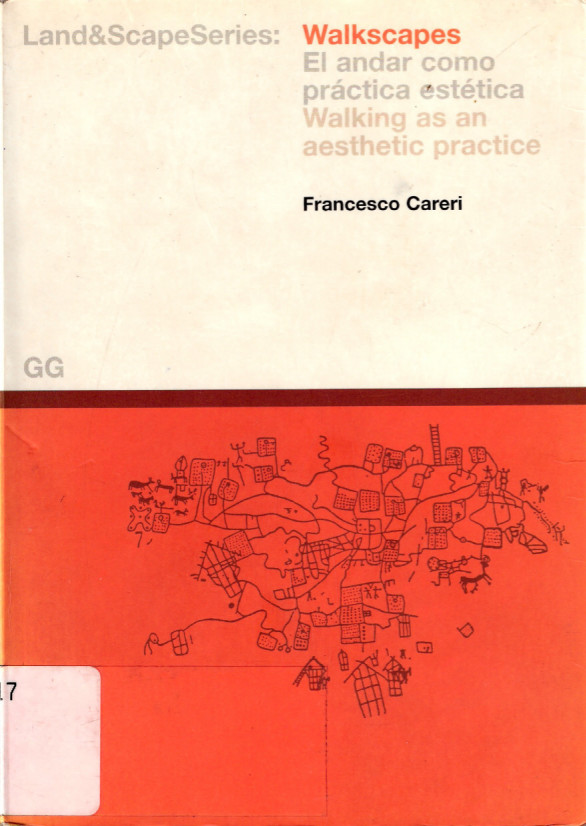Francesco Careri: Walkscapes: El andar como práctica estética / Walking as an Aesthetic Practice (2002) [Spanish/English]
Filed under book | Tags: · aesthetics, art history, city, dada, land art, landscape, lettrism, minimal art, nomadism, situationists

Walkscapes deals with strolling as an architecture of landscape. Walking as an autonomous form of art, a primary act in the symbolic transformation of the territory, an aesthetic instrument of knowledge and a physical transformation of the “negotiated” space, which is converted into an urban intervention. From primitive nomadism to Dada and Surrealism, from the Lettrist to the Situationist International, and from Minimalism to Land Art, this book narrates the perception of landscape through a history of the traversed city.
With an Introduction by Gilles Tiberghien
English translation: Steve Piccolo, Paul Hammond
Publisher Editorial Gustavo Gili, Barcelona, 2002
Land&Scape series
ISBN 8425218411
205 pages
PDF (removed on 2017-4-1 upon request of the publisher)
Comment (0)John M. Picker: Victorian Soundscapes (2003)
Filed under book | Tags: · 1800s, acoustics, history of literature, listening, literature, music, noise, phonograph, recording, silence, sound, sound recording, united kingdom, voice

“Far from the hushed restraint we associate with the Victorians, their world pulsated with sound. This book shows how, in more ways than one, Victorians were hearing things. The representations close listeners left of their soundscapes offered new meanings for silence, music, noise, voice, and echo that constitute an important part of the Victorian legacy to us today. In chronicling the shift from Romantic to modern configurations of sound and voice, Picker draws upon literary and scientific works to recapture the sense of aural discovery figures such as Babbage, Helmholtz, Freud, Bell, and Edison shared with the likes of Dickens, George Eliot, Tennyson, Stoker, and Conrad.”
Publisher Oxford University Press, 2003
ISBN 0195151917, 9780195151916
220 pages
PDF, PDF (updated on 2017-3-2)
Comments (4)Michel Meulders: Helmholtz: From Enlightenment to Neuroscience (2001/2010)
Filed under book | Tags: · 1800s, biography, empiricism, enlightenment, history of science, music, neurophysiology, neuroscience, physiology, psychology, science, vision

“Although Hermann von Helmholtz was one of most remarkable figures of nineteenth-century science, he is little known outside his native Germany. Helmholtz (1821-1894) made significant contributions to the study of vision and perception and was also influential in the painting, music, and literature of the time; one of his major works analyzed tone in music. This book, the first in English to describe Helmholtz’s life and work in detail, describes his scientific studies, analyzes them in the context of the science and philosophy of the period—in particular the German Naturphilosophie—and gauges his influence on today’s neuroscience.
Helmholtz, trained by Johannes Müller, one of the best physiologists of his time, used a resolutely materialistic and empirical scientific method in his research. This puts him in the tradition of Kant and the English empirical philosophers and directly opposed to the idealists and naturalists who interpreted nature based on metaphysical presuppositions. Helmholtz’s research on color vision put him at odds with Goethe’s more romantic theorizing on the subject; but at the end of his life, Helmholtz honored Goethe’s contributions, acknowledging that artistic intuition could reveal truths about the human mind that are inaccessible to science.
Helmholtz’s work, eclipsed at the beginning of the twentieth century by new ideas in neurophysiology, has recently been rediscovered. We can now recognize in Helmholtz’s methods–which were based on his belief in the interconnectedness of physiology and psychology–the origins of neuroscience.”
Originally published as Helmholtz: Des lumières aux neurosciences, Odile Jacob, Paris, 2001
Translated and edited by Laurence Garey
Publisher MIT Press, 2010
ISBN 0262014483, 9780262014489
235 pages
PDF, PDF (updated on 2018-8-5)
Comments (2)
